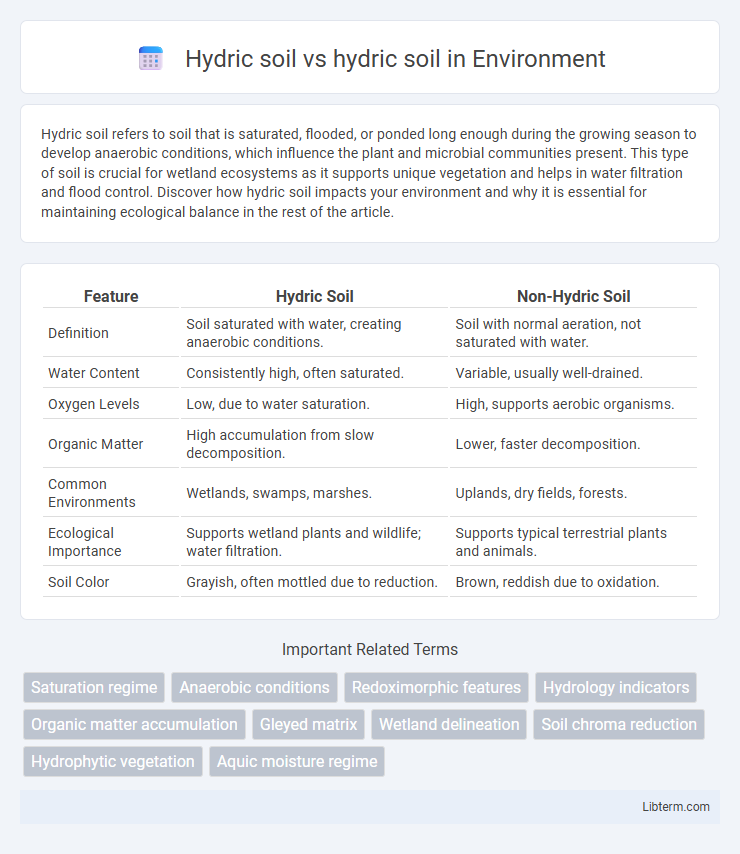Hydric soil refers to soil that is saturated, flooded, or ponded long enough during the growing season to develop anaerobic conditions, which influence the plant and microbial communities present. This type of soil is crucial for wetland ecosystems as it supports unique vegetation and helps in water filtration and flood control. Discover how hydric soil impacts your environment and why it is essential for maintaining ecological balance in the rest of the article.
Table of Comparison
| Feature | Hydric Soil | Non-Hydric Soil |
|---|---|---|
| Definition | Soil saturated with water, creating anaerobic conditions. | Soil with normal aeration, not saturated with water. |
| Water Content | Consistently high, often saturated. | Variable, usually well-drained. |
| Oxygen Levels | Low, due to water saturation. | High, supports aerobic organisms. |
| Organic Matter | High accumulation from slow decomposition. | Lower, faster decomposition. |
| Common Environments | Wetlands, swamps, marshes. | Uplands, dry fields, forests. |
| Ecological Importance | Supports wetland plants and wildlife; water filtration. | Supports typical terrestrial plants and animals. |
| Soil Color | Grayish, often mottled due to reduction. | Brown, reddish due to oxidation. |
Introduction to Hydric Soil
Hydric soil forms in saturated conditions, often found in wetlands, where anaerobic processes dominate due to prolonged water saturation. These soils exhibit unique characteristics such as reduced iron and manganese compounds, organic matter accumulation, and distinct color patterns like grayish hues or mottling. Understanding hydric soils is critical for wetland delineation, environmental regulation, and ecosystem function assessment.
Definition of Hydric Soil
Hydric soil is defined as soil that is saturated, flooded, or ponded long enough during the growing season to develop anaerobic conditions, essential for supporting wetland vegetation. This type of soil typically displays characteristics such as low redox potential, presence of organic matter, and specific color patterns like gleying or mottling. Its identification is crucial for wetland delineation and environmental regulation compliance.
Characteristics of Hydric Soils
Hydric soils are characterized by prolonged saturation, leading to anaerobic conditions that significantly influence soil chemistry and biology. These soils typically display features such as dark coloration from organic matter accumulation, mottling due to iron reduction, and a strong presence of hydrogen sulfide compounds. Their physical properties include poor drainage, high water retention capacity, and an abundance of redoximorphic features indicative of fluctuating water tables.
Importance of Hydric Soil in Ecosystems
Hydric soil plays a crucial role in ecosystem functionality by supporting wetland habitats that regulate water flow, enhance nutrient cycling, and provide critical refuges for diverse plant and animal species. These soils facilitate carbon sequestration and help mitigate climate change by storing organic matter in saturated conditions. Protecting hydric soils ensures the preservation of biodiversity, water quality, and flood control within natural landscapes.
Hydric Soil Criteria and Indicators
Hydric soil criteria include saturated conditions, anaerobic processes, and specific redoximorphic features such as iron reduction and organic matter accumulation. Indicators of hydric soils often involve the presence of gray colors, sulfur smells, and distinctive microbial activity reflecting prolonged water saturation. These characteristics are essential for identifying wetland boundaries and guiding environmental assessments.
Methods for Identifying Hydric Soils
Hydric soils are identified using field indicators such as low chroma colors, presence of redoximorphic features, and water saturation evidence during the growing season. Laboratory methods include soil texture analysis, organic matter content measurement, and chemical tests for iron and sulfur compounds associated with anaerobic conditions. Combining field observations with soil morphology and hydrology data ensures accurate classification of hydric soils for wetland delineation and environmental assessments.
Common Misconceptions about Hydric Soils
Common misconceptions about hydric soils include the belief that all hydric soils are constantly saturated or flooded, whereas these soils only require periodic saturation sufficient to create anaerobic conditions. Another misunderstanding is that hydric soils are uniformly composed of peat or muck; however, they encompass a variety of textures, including mineral soils with hydric indicators such as redoximorphic features. These inaccuracies hinder effective wetland delineation and soil management practices critical for environmental conservation and regulatory compliance.
Differences Among Hydric Soil Types
Hydric soils vary primarily in their texture, organic content, and degree of saturation, which influence water retention and aeration properties. Organic hydric soils, such as peat and muck, contain high amounts of decomposed plant material, while mineral hydric soils consist mostly of inorganic minerals with varying organic layers. Differences in redoximorphic features and soil color help identify distinct hydric soil types, affecting their ecological roles and suitability for wetland vegetation.
Environmental and Legal Implications of Hydric Soils
Hydric soils, characterized by prolonged saturation, play a critical role in supporting wetland ecosystems and maintaining biodiversity while acting as natural water filters and carbon sinks. Environmental regulations such as the Clean Water Act in the United States protect these soils by restricting activities that could lead to their degradation or destruction, ensuring wetland preservation. Legal implications encompass mandatory wetland delineation and permitting processes for land development, with penalties for non-compliance aimed at preventing habitat loss and maintaining ecosystem services.
Conclusion: The Role of Hydric Soils in Wetland Management
Hydric soils play a crucial role in wetland management by supporting unique ecosystems and regulating water quality and quantity. These soils, characterized by saturation and anaerobic conditions, foster biodiversity and serve as natural filters for pollutants. Effective wetland conservation relies on the proper identification and protection of hydric soils to maintain ecological balance and flood mitigation.
Hydric soil Infographic

 libterm.com
libterm.com